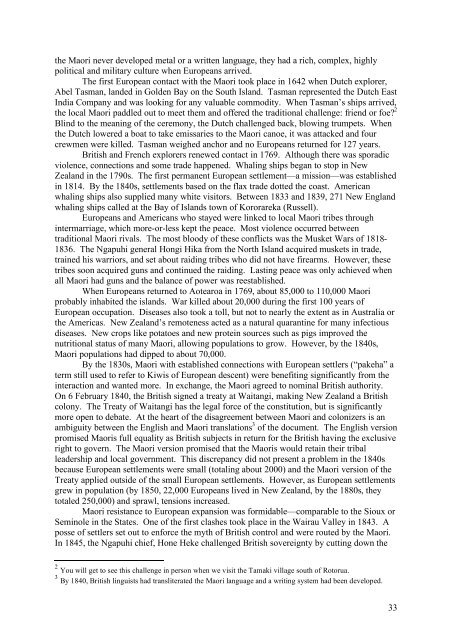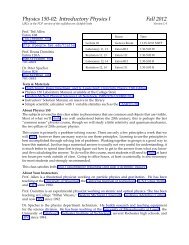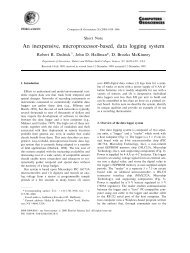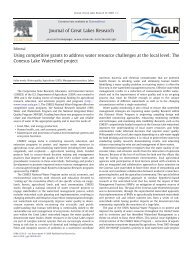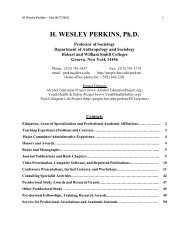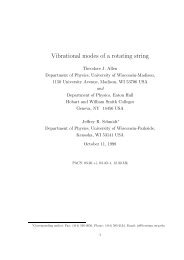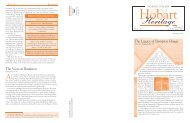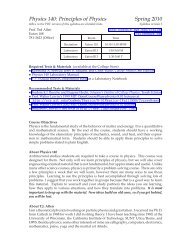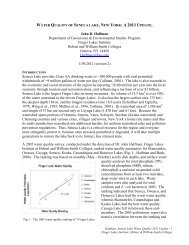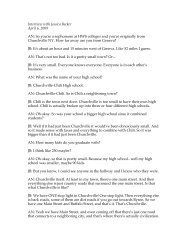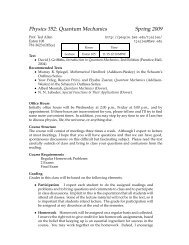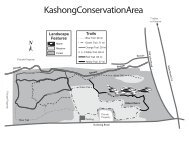Geology of New Zealand Field Trip Guidebook - ResearchGate
Geology of New Zealand Field Trip Guidebook - ResearchGate
Geology of New Zealand Field Trip Guidebook - ResearchGate
You also want an ePaper? Increase the reach of your titles
YUMPU automatically turns print PDFs into web optimized ePapers that Google loves.
the Maori never developed metal or a written language, they had a rich, complex, highly<br />
political and military culture when Europeans arrived.<br />
The first European contact with the Maori took place in 1642 when Dutch explorer,<br />
Abel Tasman, landed in Golden Bay on the South Island. Tasman represented the Dutch East<br />
India Company and was looking for any valuable commodity. When Tasman’s ships arrived,<br />
the local Maori paddled out to meet them and <strong>of</strong>fered the traditional challenge: friend or foe? 2<br />
Blind to the meaning <strong>of</strong> the ceremony, the Dutch challenged back, blowing trumpets. When<br />
the Dutch lowered a boat to take emissaries to the Maori canoe, it was attacked and four<br />
crewmen were killed. Tasman weighed anchor and no Europeans returned for 127 years.<br />
British and French explorers renewed contact in 1769. Although there was sporadic<br />
violence, connections and some trade happened. Whaling ships began to stop in <strong>New</strong><br />
<strong>Zealand</strong> in the 1790s. The first permanent European settlement—a mission—was established<br />
in 1814. By the 1840s, settlements based on the flax trade dotted the coast. American<br />
whaling ships also supplied many white visitors. Between 1833 and 1839, 271 <strong>New</strong> England<br />
whaling ships called at the Bay <strong>of</strong> Islands town <strong>of</strong> Kororareka (Russell).<br />
Europeans and Americans who stayed were linked to local Maori tribes through<br />
intermarriage, which more-or-less kept the peace. Most violence occurred between<br />
traditional Maori rivals. The most bloody <strong>of</strong> these conflicts was the Musket Wars <strong>of</strong> 1818-<br />
1836. The Ngapuhi general Hongi Hika from the North Island acquired muskets in trade,<br />
trained his warriors, and set about raiding tribes who did not have firearms. However, these<br />
tribes soon acquired guns and continued the raiding. Lasting peace was only achieved when<br />
all Maori had guns and the balance <strong>of</strong> power was reestablished.<br />
When Europeans returned to Aotearoa in 1769, about 85,000 to 110,000 Maori<br />
probably inhabited the islands. War killed about 20,000 during the first 100 years <strong>of</strong><br />
European occupation. Diseases also took a toll, but not to nearly the extent as in Australia or<br />
the Americas. <strong>New</strong> <strong>Zealand</strong>’s remoteness acted as a natural quarantine for many infectious<br />
diseases. <strong>New</strong> crops like potatoes and new protein sources such as pigs improved the<br />
nutritional status <strong>of</strong> many Maori, allowing populations to grow. However, by the 1840s,<br />
Maori populations had dipped to about 70,000.<br />
By the 1830s, Maori with established connections with European settlers (“pakeha” a<br />
term still used to refer to Kiwis <strong>of</strong> European descent) were benefiting significantly from the<br />
interaction and wanted more. In exchange, the Maori agreed to nominal British authority.<br />
On 6 February 1840, the British signed a treaty at Waitangi, making <strong>New</strong> <strong>Zealand</strong> a British<br />
colony. The Treaty <strong>of</strong> Waitangi has the legal force <strong>of</strong> the constitution, but is significantly<br />
more open to debate. At the heart <strong>of</strong> the disagreement between Maori and colonizers is an<br />
ambiguity between the English and Maori translations 3 <strong>of</strong> the document. The English version<br />
promised Maoris full equality as British subjects in return for the British having the exclusive<br />
right to govern. The Maori version promised that the Maoris would retain their tribal<br />
leadership and local government. This discrepancy did not present a problem in the 1840s<br />
because European settlements were small (totaling about 2000) and the Maori version <strong>of</strong> the<br />
Treaty applied outside <strong>of</strong> the small European settlements. However, as European settlements<br />
grew in population (by 1850, 22,000 Europeans lived in <strong>New</strong> <strong>Zealand</strong>, by the 1880s, they<br />
totaled 250,000) and sprawl, tensions increased.<br />
Maori resistance to European expansion was formidable—comparable to the Sioux or<br />
Seminole in the States. One <strong>of</strong> the first clashes took place in the Wairau Valley in 1843. A<br />
posse <strong>of</strong> settlers set out to enforce the myth <strong>of</strong> British control and were routed by the Maori.<br />
In 1845, the Ngapuhi chief, Hone Heke challenged British sovereignty by cutting down the<br />
2 You will get to see this challenge in person when we visit the Tamaki village south <strong>of</strong> Rotorua.<br />
3 By 1840, British linguists had transliterated the Maori language and a writing system had been developed.<br />
33


